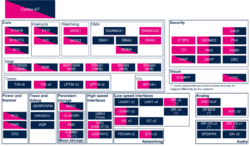- Last edited 10 months ago ago
DCMIPP internal peripheral
Contents
1 Article purpose[edit]
The purpose of this article is to:
- briefly introduce DCMIPP peripheral and its main features
- indicate the level of security supported by this hardware block
- explain how each instance can be allocated to the runtime contexts and linked to the corresponding software components
- explain, when needed, how to configure DCMIPP peripheral.
2 Peripheral overview[edit]
The DCMIPP (digital camera memory interface pixel processor) is an STM32 internal peripheral allowing the reception of video data from an external parallel camera sensor device, or from any other digital video equipment supporting a parallel interface.
The DCMIPP hardware block can receive various frame data formats such as: RAW8, RGB565, YUV422 and other formats, as well as compressed data such as JPEG.
2.1 Features[edit]
Refer to STM32MP13 reference manuals for the complete list of features, and to the software components introduced below, to see which features are actually implemented.
2.2 Security support[edit]
The DCMIPP is a non-secure peripheral.
3 Peripheral usage and associated software[edit]
3.1 Boot time[edit]
The DCMIPP is not used at boot time.
3.2 Runtime[edit]
3.2.1 Overview[edit]
The DCMIPP internal peripheral can be allocated to:
- the Arm® Cortex®-A7 non-secure core to be used under Linux® with the V4L2 framework
or
- the Arm® Cortex® -M4 core to be used with STM32Cube MPU Package with DCMIPP HAL driver
Chapter Peripheral assignment describes which peripheral instance can be assigned to which context.
3.2.2 Software frameworks[edit]
| Domain | Peripheral | Software components | Comment | |
|---|---|---|---|---|
| OP-TEE | Linux | |||
| Visual | DCMIPP | V4L2 framework | ||
3.2.3 Peripheral configuration[edit]
The configuration is applied by the firmware running in the context to which the peripheral is assigned. The configuration can be done alone via the STM32CubeMX tool for all internal peripherals. It can then be manually completed (particularly for external peripherals), according to the information given in the corresponding software framework article, or in the DCMIPP device tree configuration article for Linux®.
3.2.4 Peripheral assignment[edit]
Click on the right to expand the legend...
Check boxes illustrate the possible peripheral allocations supported by STM32 MPU Embedded Software:
- ☐ means that the peripheral can be assigned (☑) to the given runtime context.
- ⬚ means that the peripheral can be assigned to the given runtime context, but this configuration is not supported in STM32 MPU Embedded Software distribution.
- ✓ is used for system peripherals that cannot be unchecked because they are statically connected in the device.
Refer to How to assign an internal peripheral to an execution context for more information on how to assign peripherals manually or via STM32CubeMX.
The present chapter describes STMicroelectronics recommendations or choice of implementation. Additional possiblities might be described in STM32MP13 reference manuals.
| Domain | Peripheral | Runtime allocation | Comment | ||
|---|---|---|---|---|---|
| Instance | Cortex-A7 secure (OP-TEE) |
Cortex-A7 non-secure (Linux) | |||
| Visual | DCMIPP | DCMIPP | ☐ | ||


